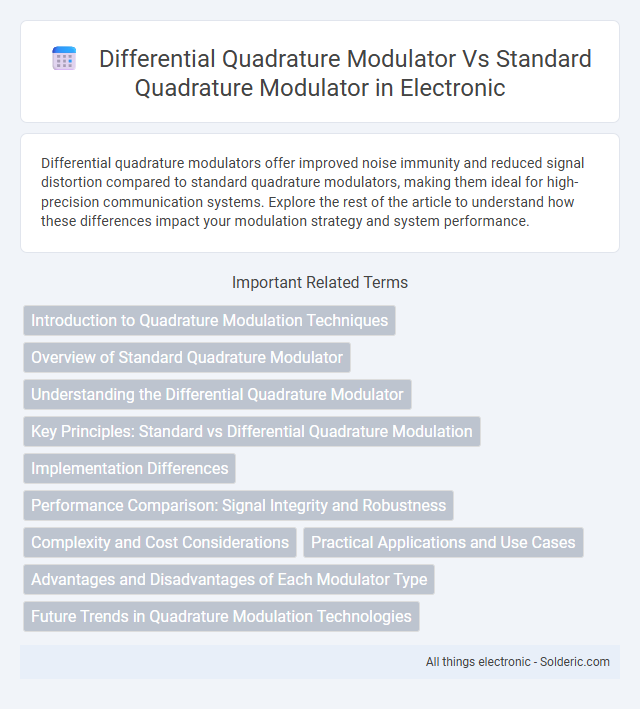Differential quadrature modulators offer improved noise immunity and reduced signal distortion compared to standard quadrature modulators, making them ideal for high-precision communication systems. Explore the rest of the article to understand how these differences impact your modulation strategy and system performance.
Comparison Table
| Feature | Differential Quadrature Modulator | Standard Quadrature Modulator |
|---|---|---|
| Signal Type | Differential signals | Single-ended signals |
| Noise Immunity | High (better common-mode noise rejection) | Lower (more susceptible to noise) |
| Linearity | Improved linearity due to balanced operation | Moderate linearity |
| Power Consumption | Typically higher due to differential circuits | Generally lower power consumption |
| Complexity | More complex design and layout | Simpler design |
| Output Dynamic Range | Wider dynamic range | Narrower dynamic range |
| Application | High-performance wireless communications, high linearity needs | General-purpose modulation, cost-sensitive applications |
Introduction to Quadrature Modulation Techniques
Quadrature modulation techniques enable the transmission of two signals simultaneously by varying amplitude and phase components in in-phase (I) and quadrature (Q) channels. Differential quadrature modulators improve robustness against phase noise and frequency offset by encoding data through phase differences between symbols, while standard quadrature modulators directly modulate absolute phase values, often requiring more complex synchronization. Understanding the distinctions between these techniques helps you optimize signal fidelity and reduce errors in complex communication systems.
Overview of Standard Quadrature Modulator
Standard quadrature modulators generate two orthogonal signals, typically sine and cosine waves, to modulate separate data streams onto I (in-phase) and Q (quadrature-phase) components, facilitating complex signal transmission. These modulators are widely used in communication systems for efficient bandwidth utilization and improved spectral efficiency by enabling simultaneous transmission of amplitude and phase information. Despite their effectiveness, standard quadrature modulators can suffer from imperfections like amplitude imbalance and phase error, impacting modulation accuracy and overall system performance.
Understanding the Differential Quadrature Modulator
The Differential Quadrature Modulator (DQM) improves signal integrity by using phase and amplitude differences between two input signals to reduce noise and distortion compared to standard quadrature modulators. Your communication system benefits from enhanced linearity and reduced spurious emissions, leading to better performance in complex modulation schemes. Understanding the DQM's differential processing mechanism is crucial for optimizing modulation precision in advanced RF applications.
Key Principles: Standard vs Differential Quadrature Modulation
Standard quadrature modulators generate in-phase (I) and quadrature-phase (Q) signals by mixing the input with cosine and sine carriers, emphasizing fixed phase relationships for signal modulation. Differential quadrature modulators encode information based on phase differences between consecutive symbols, enhancing robustness against phase noise and improving spectral efficiency. This key principle shift allows differential schemes to better tolerate impairments in communication systems compared to standard quadrature modulation.
Implementation Differences
Differential quadrature modulators utilize differential signaling to improve noise immunity and reduce electromagnetic interference, unlike standard quadrature modulators that rely on single-ended signals. The implementation of differential modulators often involves balanced mixers and differential amplifiers, increasing the circuit complexity and power consumption compared to standard designs. Your choice between these modulators depends on the application requirements for signal integrity and environmental noise resilience.
Performance Comparison: Signal Integrity and Robustness
Differential quadrature modulators exhibit superior signal integrity compared to standard quadrature modulators due to their enhanced common-mode noise rejection and reduced even-order distortions, leading to cleaner output signals in RF communication systems. The robustness of differential modulators against power supply variations and electromagnetic interference surpasses that of standard designs, ensuring consistent performance in harsh environments. This improved noise immunity and distortion suppression make differential quadrature modulators preferable for applications requiring high linearity and dynamic range.
Complexity and Cost Considerations
Differential quadrature modulators typically exhibit higher complexity due to the requirement for balanced signal paths and precise differential components, leading to increased design efforts and component counts compared to standard quadrature modulators. Standard quadrature modulators often benefit from simpler architectures and lower cost implementations, making them more suitable for applications where budget and design simplicity are paramount. When choosing between the two, Your decision should weigh the added performance benefits of differential modulation against its potential impact on overall system complexity and cost.
Practical Applications and Use Cases
Differential quadrature modulators offer enhanced noise immunity and improved linearity, making them ideal for high-performance communication systems such as advanced radar and software-defined radios. Standard quadrature modulators are commonly used in simpler applications like baseband signal processing and cost-sensitive wireless transceivers. Your choice depends on system complexity and performance requirements, with differential designs favored in demanding environments requiring precise signal integrity.
Advantages and Disadvantages of Each Modulator Type
Differential quadrature modulators offer superior noise immunity and enhanced signal integrity by processing phase and amplitude differences, which makes them ideal for high-precision communication systems. Standard quadrature modulators, while simpler and cost-effective, often suffer from phase imbalance and image rejection issues, leading to signal distortion and reduced performance in complex environments. Your choice depends on whether you prioritize signal purity and robustness (differential modulators) or lower cost and design simplicity (standard modulators).
Future Trends in Quadrature Modulation Technologies
Future trends in quadrature modulation technologies emphasize enhanced spectral efficiency and reduced phase noise through advancements in differential quadrature modulators compared to standard quadrature modulators. Differential quadrature modulators offer improved immunity to DC offsets and I/Q imbalances, enabling more robust performance in high-frequency 5G and beyond wireless communication systems. Integration of machine learning algorithms and CMOS technology scaling further accelerates the adoption of differential architectures for next-generation broadband and IoT applications.
Differential quadrature modulator vs standard quadrature modulator Infographic

 solderic.com
solderic.com